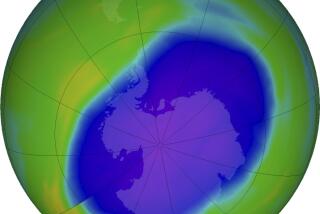Ozone Depletion Is Year-Round, Scientists Find
- Share via
WASHINGTON — Thinning of the ozone layer, once thought to be a seasonal polar phenomenon, actually is occurring over the United States and the rest of the world in spring and summer--a time when the risk of skin cancer is already at its greatest--an international scientific panel told the United Nations Tuesday.
The conclusion, based on new data gathered by both ground-based and orbiting instruments, comes only six months after the Environmental Protection Agency warned that ozone layer depletion would result in millions more cases of skin cancer and two weeks after the “ozone hole” over the Antarctic was reported to be the most severe ever recorded.
The ozone layer, 10 to 15 miles above the ground, absorbs some of the sun’s cancer-causing ultraviolet radiation. Summertime ozone depletion allows increased levels of the damaging ultraviolet rays to reach the Earth’s surface at a time when millions of Americans are going to the nation’s beaches.
Despite that, Environmental Protection Agency Administrator William K. Reilly said there are no plans to update skin cancer predictions that the agency made in April. At that time, with the discovery that ozone had depleted over the United States during the winter and spring, the EPA estimated that the next 50 years would see as many as 12 million additional skin cancers, and perhaps 200,000 additional deaths from the disease.
In another surprising discovery, the researchers said that depletion of the ozone layer is cooling the upper atmosphere ever so slightly, perhaps modestly slowing global warming, said the U.N. panel’s co-chairman, Daniel Albritton of the National Oceanic and Atmospheric Administration.
Thus, in addition to raising new concerns over human exposure to damaging ultraviolet radiation, the report raised new questions for scientists studying climatic changes believed to stem from so-called greenhouse gases, such as carbon dioxide and methane.
Speaking at a Washington conference on global warming two hours before release of the report at the United Nations, White House Science Adviser D. Allan Bromley said that the new findings “throw into question much of what we believed we knew about the atmospheric chemistry of a number of important greenhouse gases.
“This again provides a vivid demonstration of how great is our remaining ignorance of such matters and how probable are substantial surprises. There is much that we still do not understand about our atmosphere and the behavior of its component gases.”
The new assessment for the United Nations Environmental Program and the World Meteorological Organization was mandated as a follow-up to an international agreement to phase out the use of chlorofluorocarbons, gases such as Freon, widely used as refrigerants and industrial solvents but that have been found to destroy atmospheric ozone. Leaders of the study were Robert Watson of the National Aeronautics and Space Administration and Albritton.
Environmentalists reacted to the report with a chorus of calls to speed up the phase-out of CFCs and other ozone-depleting chemicals.
“The new findings indicate that people are at additional risk of skin cancer from outdoor activity at the height of vacation season,” said Michael Oppenheimer of the Environmental Defense Fund. This report demands an urgent response by governments.”
The Defense Fund and a coalition of other environmental groups plan to ask the U.S. government to take immediate steps to toughen deadlines, Oppenheimer said.
Sen. Albert Gore Jr. (D-Tenn.) said that he will reintroduce a Senate resolution calling for an acceleration of the phase-out of ozone-depleting chemicals. The measure was first offered last spring after the EPA produced its new skin cancer estimates.
Under the 1987 agreement known as the Montreal Protocols, 53 industrial nations pledged to eliminate the use of CFCs and similar chemicals known as Halon by the year 2,000. Last year, the agreement was strengthened when other chlorine-based chemicals such as methyl chloroform and carbon tetrachloride were added to the list of those to be eliminated. Signatories of the protocols are due to meet again next summer to further update the pact.
Even before Tuesday’s disclosure, environmentalists were calling for tighter controls on so-called HCFC’s--chemicals being produced as CFC substitutes. Though less damaging, the substitutes, like CFCs themselves, are chlorine based and therefore destroy ozone molecules.
Coming after a succession of discoveries about worsening depletion in the polar regions, expansion of damage closer to the Equator and a persistence of damage into mid-summer, the new report triggered speculation that the depletion is a continuous, worsening process rather than a cyclical, regional phenomenon as once thought.
“The $64,000 question,” said a NASA scientist, is whether we are seeing an acceleration of the depletion, and I am fearful that is the case.”






